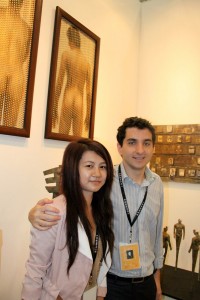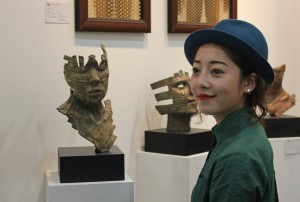by Jesus Manuel Rojas
Colombian-born Joaquin Restrepo, 27 is an artist from Bogota who recently visited Shanghai for the first time exhibiting his paintings and sculptures at Bandi-Trazos Gallery at the American Pavilion Shanghai Art Fair.
WUM takes a moment to talk to this young talented emergent artist to get his impressions about China and talk about his innate process of creation and curiosity.
First off, tell us how did you start a career in the arts?
I have been curious and eager to learn my whole life. When I was a teenager, around 12 or so, I wanted to be trained by masters from my own country. So after a long search, I found renown teachers such as Deborah Arango and David Manzur from Colombia to teach me art. I also received teachings from US artist Ethel Gilmour.
After High School, I applied to study art at the Universidad de los Andes in Bogota which was known to have an inclination toward Contemporary art. Since I was already receiving classes from Modern Colombian masters, I thought that it would be the right approach to have a mixed educational training.

Joaquin Restrepo and his translator Tan Xiao Wen
Did anyone in your family notice your unquestionable inclination towards the arts?
Nobody noticed anything; I was a very curious child and from an early age I had an interest toward computers and music. I remember going to the theatre to listen to Opera and asking for permission to go behind-the-scenes to take a glimpse of what was going on behind the curtains.
Did you want to see how they were able to put on that show?
Yes, I love to see how things work. I love to see how the whole process works. Such innate curiosity led me to meet up later in my life with renown masters such as Fernando Botero and Edgar Negret.
Why did you want to meet these masters? Was it curiosity as a student or just for plain admiration?
I think it was for the love of art that I wanted to ask these masters how they did it. I was curious to see how they were able to sculpt or to paint. I had a true desire to interact with the artists and watch them work. At College, the learning experience is very different, a passive one; there’s almost no real feedback between the teacher and the student but when you are interacting directly with an artist, you take whatever you want, whatever pleases you because the artist is not interested in making you work on something like in regular College classes. I remember doing the same with my classmates visiting their booths to see what they were doing. I knew it would nurture me more.
So clearly you gather inspiration by so many things around you before producing your own creation.
Flexibility is important and for me it has been wonderful to be able to go on learning new techniques along the way.
So you are truly a self-taught artist, in the real sense, that you went on discovering about the arts on your own way.
Yes, I don’t know why. I have always had this inclination towards the arts; it’s like an innate impulse.
Did you finish school?
I didn’t finish; I had only two semesters left. It was very strange for me, I was receiving advice from other teachers and masters outside School and a new world of opportunities opened up in front of me. While I was at school, I was already going to auctions. Nobody knew about this.
Did your classmates or teachers never found out about it?

Joaquin Restrepo and Fellipe Gardela Argentina’s vice-consul
No. I kept it a secret. I was already selling. I was 18 when I went to my first auction.
Where did the auctions take place?
In Bogota. They were organized by Christie’s New York.
So you felt like going to School did not mean much to you because you were already making some bucks, right?
For me it’s not about selling. I want to feel good making what I want with love. I liked School but it was more experimental for me; I loved to challenge my teachers on the works I was producing.
What are your impressions of the China market so far?
I see many people interested in my works. I had to hire a translator for me to get a real feedback on their views about my works. They want to see my development; they have seen me with Bandi-Trazos before. It has been a great opportunity for me to be in this pavilion and to make contacts with Shanghai museums and galleries so far. I am looking forward to come over here to live and work.
What are you doing next?
On September 22 and on October 27, I will be showing my works in Colombia in a solo exhibition and at an auction as well. I will be showing for the first time the paintings I am showing here in Shanghai and for the auction, I will be exhibiting a very large size fish sculpture, a 3.20 meters high sculpture made with knives.
Tell us the story behind “The Fish” made with knives which will benefit the Police Department.
These are knives confiscated by the Police Department, real knives which have hurt other people. I first started this project taking photographs of the knives, imagining the many stories behind them. I was impressed to find many of them as beautifully crocheted daggers. I asked myself, what were they thinking when they were doing it? I arranged them edgewise so the sharp edge goes in and inside are the other confiscated knives, the innocent ones that never hurt anybody.
How did you get the permits from the Police to access those weapons?
It was such a challenge. I don’t usually show anything before the auction. I thought it was a challenging proposal; they obtained all the permits and here I am making this big fish showing the beautiful side of many horror stories which will be placed in the most important public park of Bogota and then it will go for auction in November.
COPYRIGHTS ® 25 de Septiembre de 2011 WUM25




